The content of the article
Getting a cat, you need to understand that from the moment when his paw crosses the threshold of the house, the owner is fully responsible for his health and well-being. Many people consider their pet to be one of the family members, and a full one. Therefore, games alone are not enough to make the cat feel comfortable. He needs to pay attention, train, monitor his nutrition and health. Nevertheless, despite proper care, sometimes the animals still get sick, and the owner is the only person who can help him. Sometimes it can be a medication, sometimes a vaccination, and sometimes ... an enema.
This delicate process will be a necessary measure in the fight against cat constipation. Of course, it is best to consult a veterinarian when the owner has seen signs of deterioration in the animal’s health status. But sometimes there are times when it is not possible to do this, and the owner is forced to carry out this procedure on his own.
It should be noted that the use of an enema is strictly contraindicated if the cat:
- worms;
- damage to internal organs, in particular the intestines;
- inflammation in the body;
- intestinal bleeding, anal fissures;
- pregnancy.
Important! To understand whether the animal has the above circumstances, and whether the cat is allowed to do an enema, you can only by consulting with a veterinarian. Also, the veterinarian must give recommendations for the independent conduct of this procedure.
In the event that the animal does not suffer from such ailments, before making an enema, you should make sure that the cat is really worried about constipation.
Signs of constipation
During normal operation of the animal’s body, the cat should “visit” the toilet at least 2 times a day. If this amount is reduced to 1 time per day or to 1 time in 2 days, you can judge the presence of constipation. In addition, there are other changes in the animal:
- lethargy, passivity in relation to games;
- the desire to constantly sit in the hands of the owner;
- lack of appetite;
- bloating with palpation of the abdomen;
- pain when trying to defecate, expressed by meowing;
- molting at an advanced stage.
The presence of these signs also indicates constipation in the cat. However, just doing an enema and leaving the animal alone is not enough. It is important to understand the cause of constipation, and to prevent its reappearance.
Causes of constipation
Constipation is not a disease, but a symptom that needs to be addressed to prevent the development of serious diseases. The reasons for their appearance can be very diverse, up to the fact that the animal organism itself is predisposed to the appearance of constipation. However, there are a number of reasons:
- Unbalanced diet, insufficient fiber in the feed.
- Accumulation of wool in the intestines.
- Poisoning.
- Congenital change in internal organs.
- Neurology.
- Hernia in the perineum.
- Diseases of the anus.
- Diseases of the digestive tract.
- Foreign object in the intestines.
After the cause of constipation has been found (with the help of a veterinarian), it should be eliminated as soon as possible. However, if constipation has already formed, it is necessary to start using an enema.
Enema Procedure
Important! You should resort to the use of an enema only if other measures have not yielded positive results. That is, taking laxatives and drinking plenty of fluids.
After consulting with a specialist, the owner needs to prepare for the medical procedure. To carry it out you will need:
- Since the “human” pear is not suitable for an enema, you will have to buy a special enema kit in a veterinary pharmacy.
- Water with a little salt or chamomile broth.
- Grease (greasy cream, petroleum jelly, vegetable oil).
- Medical gloves.
- Blanket - in case the animal breaks out and scratches badly.
- Capacity for an enema.
- Contingency napkins.
- Pelvis for bowel movements.
After choosing a place, you should perform a few simple steps. All subsequent manipulations must be carried out with medical gloves for hygiene purposes, because the animal suffers from the discomfort that it already experiences. Do not introduce a cat infection.
So:
- First you need to prepare an enema. It should contain up to 100 milliliters of water. To take a large enema, but not to fill it completely, is impossible, since large pears have a large tip, which in no case can be used for a cat. The device must be sterile, it is worth taking the device out of the packaging immediately before use.
- Then, from the edge of the tip, measure and mark 2 centimeters (for an adult cat) and 1 centimeter (for a kitten). This will be the depth of entry of the enema.
- Next, in a clean container, prepare the desired liquid (chamomile broth or salted water). The temperature of the solution should be approximately 28 degrees (+ - 2 degrees). The solution is prepared at the rate of 1 teaspoon of table salt (salt is not absorbed into the intestinal wall) per 0.3 liter of water (boiled).
- Lubricate the tip of the enema liberally.
Important! All manipulations should be carried out in the most sterile conditions, using clean hands and tools.
After the preparatory stage is completed, you can begin to perform the procedure itself. You need to complete in several stages.
Stage 1
This is the stage of keeping the cat in the correct position. It is necessary to hold the animal firmly, without using excessive force, in a standing position, with its back to the owner. Well, if two people do it, because not one, even the calmest animal, will behave calmly when performing this procedure.
Stage 2
The main stage of the procedure. In an enema, you need to dial a solution in the amount of 60-80 milliliters. The amount needed depends on the size of the animal. Next, you need to press the enema a little until the moment when the water begins to drip. This is necessary so that the air does not enter the intestines of the animal. Then, the pre-lubricated enema tip is carefully inserted into the anus of the cat, parallel to the spine, using rotating movements. After this, the solution should be slowly introduced. Do not worry about too much fluid getting into the animal’s body. Excess water will flow out.
Stage 3
The final stage. After the solution has been introduced, it is necessary to carefully remove the enema and close the anus with the cat's tail. Then you should turn the cat on its back or side, stroke its stomach and hold it in this position for 15 minutes. Stroking is necessary to stimulate the softening of feces. After this, it is necessary to transfer the cat to the pelvis and let the feces exit.It is necessary to constantly be next to the animal so that it does not break out and does not defecate outside the pelvis. To consolidate the effect, you can repeat the procedure after 2 hours (you must check with your veterinarian).
Recommendations regarding the procedure
Before you complete the procedure, you need to familiarize yourself with some recommendations for its implementation. Namely:
- Enemas sold in pharmacies come in different volumes, depending on the size and age of the cat. It is necessary to choose the right one. The use of "human" enemas is strictly prohibited. Also, an enema for a cat can be made in the form of a syringe with a round tip.
- Veterinary pharmacies also sell animal lubricant.
- Before performing the procedure, you should carefully study all the details and consult with a veterinarian.
- An enema is best done in the morning, on an empty stomach.
- During the procedure, you should not twitch and panic yourself, so as not to injure the animal even more. Animals feel human condition. The cat should be stroked and talking with him, he should calm down and trust the person, otherwise it will be difficult to regain trust.
- In the event that the feces at the exit are stained with blood, you should immediately contact your veterinarian.
How to avoid cat constipation
The problem is always better to prevent than to treat. Therefore, in order not to resort to such unpleasant procedures, you should:
- Comb the animal with a special cat brush, especially if the cat is long-haired, 2 times a week. You can also use special products for the natural removal of wool from the body. For cats, food is provided in which there are ingredients that contribute to this conclusion.
- Monitor the nutrition of the animal. It is especially worth paying attention to a sufficient amount of fiber in his diet. To do this, do not forget to introduce sour-milk products, vegetables and bran (wheat and oat) to the cat if the cat eats natural food. For animals that eat pre-packaged food - select only premium or super premium feed. You should also familiarize yourself with the rules of nutrition for cats with specialized food. The most favorable way of feeding is a combination of 3% wet and 70% dry food. Such a diet is not suitable for all cats, but for most.
- Make sure that the cat always has clean water in the public domain. It is advisable that this is not tap water. Bottled water is mainly used for these purposes.
- Keep track of pet activity. It is important that the animal is energetic and more likely to be in motion. To do this, it is necessary to provide him with attention and educational toys.
- Periodically it is necessary to visit a veterinarian. About once every six months. Such a habit will avoid many health problems of the pet.
In conclusion, it should be said that the formation of constipation in a cat is a signal of the beginning of emergency care for an animal. This problem should not be left to chance in any case, since a long absence of natural bowel movement in a cat can lead to poisoning and subsequent illness of the animal. However, before conducting therapeutic measures independently, it is necessary to consult with a veterinarian regarding the use of an enema and the presence of contraindications to it.
Video: cat enema at home

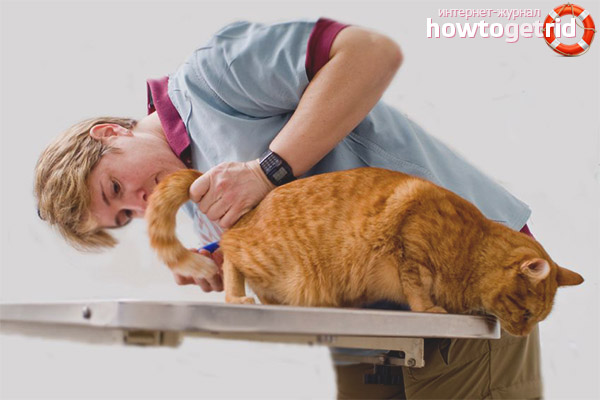
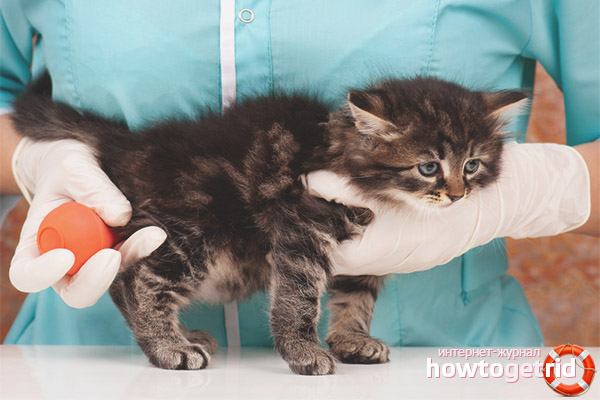
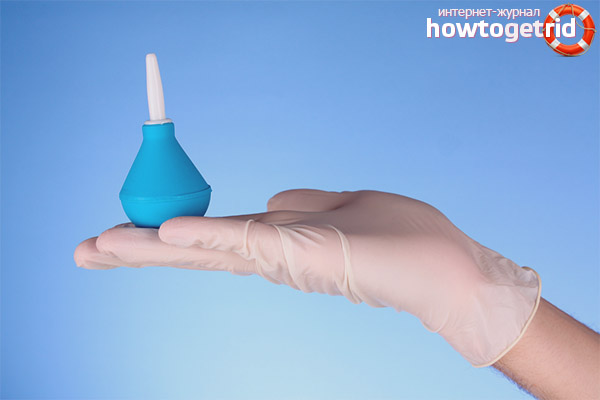



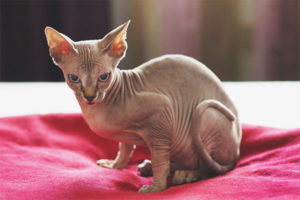
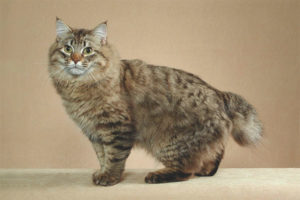
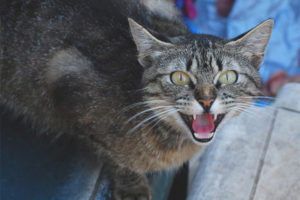
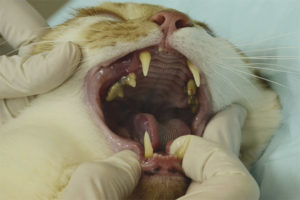
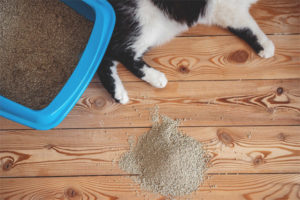
Submit